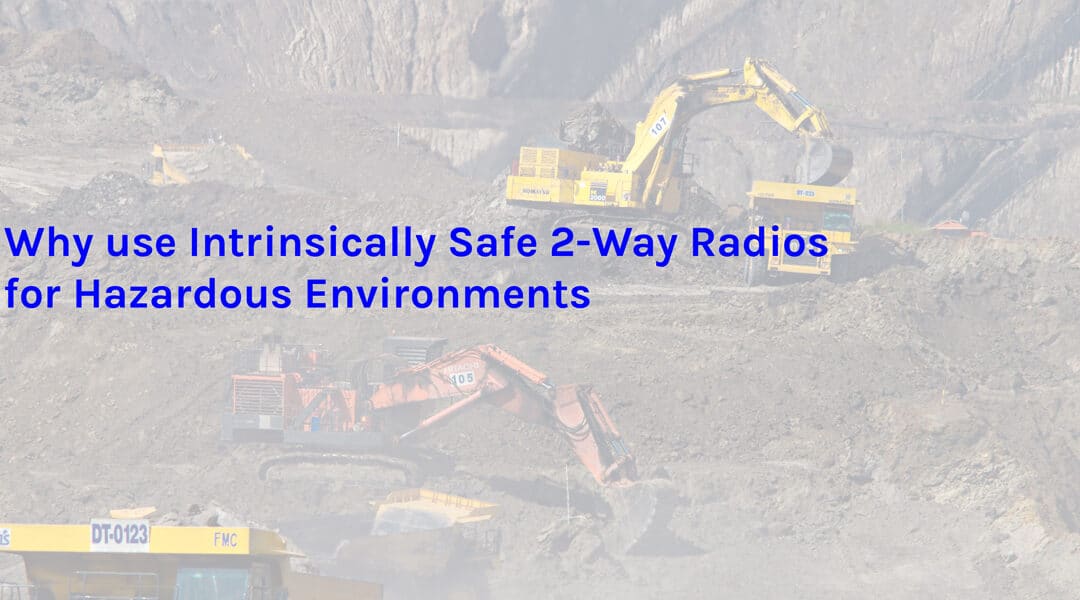Conventional 2-way radios are devices for instant communications that utilise radio frequencies (RF). They generally operate on fixed channels and are assigned a fixed frequency, allowing an easy transmission of messages to the other user in a matter of seconds. And because these are used for tactical or operational communications, they are widely popular for applications such as security, patrolling, police, military, food and banquets, schools, sports, and events, to name a few.
But there are environments where this type of product is not suitable. An electrical plant for example is where electrical or thermal energies are released frequently under normal operating conditions which can cause immediate ignition or explosions. Chemical vapours or combustible dust could be present in a specific worksite posing possible threats for people working in the field. Without a doubt, the conventional handheld radios are strictly prohibited to operate in these places. The electromagnetic radiations and their capability to induce currents in nearby metallic objects are enough to trigger these elements leading to life-threatening accidents.
Because of this, more specific walkie talkie devices are designed for this purpose. They must have gone through industry testing and are certificated before they are considered safe to use. These products are the intrinsically safe 2-way radios or IS radios.
What is Intrinsically Safe?
In a safety-conscious workplace, workers must be protected from the risks of devices becoming an ignition source.
An equipment categorised as ‘intrinsically safe’ offers explosive protection for the end user all day. These radios do not emit thermal or electrical energies that may cause ignition of combustible elements in the atmosphere. They have the appropriate intrinsically safe classification based on the material.
IS radios are more valuable as a communication tool wherever these elements are prominent:
- Fuel
- Gas
- Flammable substances
- Sparks
What makes IS radios different from the customary 2-way radios is that it they have a full encapsulation of the battery to prevent electrolyte ingress. This feature prevents overheating or internal sparking.
Where Intrinsically Safe Radios are used
There are specific work sites prone to many dangerous substances that may affect the health and safety of the workers. Using an electronic device like 2-way radios may have to be limited or not used at all because of the high chances of possible flareups. Intrinsically safe radios are specially designed to ensure this kind of protection from the electrical circuits of traditional radios. They offer true safety for workers in potentially hazardous areas. As environments can be dangerous for devices with radio frequencies, IS radios are appropriate for the following sectors:
- Oil and gas
- Petrochemical plants
- Manufacturing factories
- Electrical plants
- Mining fields
- Confined spaces
Check the certification
There are various certifications or worldwide directives that allow these radios to be operated (again, under specific circumstances). If you are looking for IS radios, you might encounter one or the following markings:
- ATEX, which came from the French title Appareils destinés à être utilisés en Atmosphères Explosives, comprises 2 EU directives that describe the work space and the equipment allowed in a potentially dangerous atmosphere. They are the Directive 99/92/EC and Directive 94/9/EC.
- Directive 99/92/EC, known as ATEX 137 or the ATEX Workplace Directive, is the minimum requirement for improving the safety and protecting the health of workers who are potentially at risk from explosive atmospheres.
- Directive 94/9/EC, known as ATEX 95 or the ATEX Equipment Directive, is the approximation of the laws of Member States regarding the equipment and protective systems for use in potentially hazardous atmospheres.
- UL is another popular certification for IS. It is a global safety organisation that offers certification for companies that demonstrate safety, confirm compliance, enhance sustainability and deliver performance. Products that are certified UL mean they have undergone extensive and rigorous tests leading to confirmation on their safety, quality and reliability. The standard for intrinsically safe apparatus and associated apparatus is the UL 913, in Class I, II or III implying that the design and construction influence the intrinsic safety of an electrical circuit.
In addition, the marking must be distinctly labelled or marked in accordance to the area where the radio will be used. The label must indicate the following: Class, Division, Group and Temperature. This is the classification system used in North America defining the type of hazardous substance present in the air in quantities sufficient to produce ignitable mixtures. Understanding the classification of the location may help organisations to understand the work site.
- Class – What are the kinds of explosive substances present in the environment
- Group – What are the materials based on ignition temperature and explosion pressure
- Division – The evaluation of location of the Class
- Temperature – Maximum operating temperatures on the surface of the equipment which should not exceed ignition temperatures of the atmosphere
The rating information must be shown on the product brochure or product specification sheet. For ATEX certification, the device is marked by the ‘Ex’ symbol (example, Hytera PD718Ex). For UL913 devices, it is suffixed with the equipment (example Hytera PD508-UL913).
How to use Intrinsically Safe Radios
- The radio and its accessories must have the approval that they are intrinsically safe. The safety marking must appear on the unit itself.
- Never charge the battery in hazardous areas.
- Never use a battery or accessory that is not rated to be intrinsically safe.
- Never use a damaged radio or accessory.
- Do not remove or install radio accessories in these locations.
- Do not use defective IS radios and accessories.
What are the best Intrinsically Safe Radios?
It is important to purchase the right intrinsically safe radio from authorised distributors. MacroVista offers a wide range of ATEX- or UL-certificated radios.
Check here for the full list of Intrinsically Safe Radios on offer
The Hytera PD708-UL913 is a UL-certified radio made exclusively for worksites that have explosive gases and combustible dusts. Meanwhile, the Hytera PD798Ex is an ATEX-certificated intrinsically safe radio following the European ATEX directives, FM and IEC standards. It has been rated to be an explosion-proof device and is sealed from dust particles and explosive gases.
Keep Your Environment Safe
Safety is of utmost priority of every business owner. Wherever there is a volatile substance that could generate heat or sparking, strictly regulated IS-approved devices must be carefully evaluated and more importantly enforced.
We at MacroVista can help you find and choose the right Intrinsically Safe 2-Way Radio suitable for the environment your team is operating in. We carry a comprehensive suite of brands considered the best in the market. Please call our Communications expert for more information today.
Singapore
Phone: +65 6748 9773
E-mail: sales@macrovista.com
Philippines
Phone: +632 633 9578
E-mail: sales@macrovista.com


Recent Comments